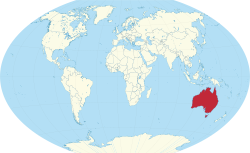Biology:Nymphaea kakaduensis
| Nymphaea kakaduensis | |
|---|---|
| Scientific classification | |
| Kingdom: | Plantae |
| Clade: | Tracheophytes |
| Clade: | Angiosperms |
| Order: | Nymphaeales |
| Family: | Nymphaeaceae |
| Genus: | Nymphaea |
| Species: | N. kakaduensis
|
| Binomial name | |
| Nymphaea kakaduensis Hellq., A.Leu & M.L.Moody[1]
| |

| |
| Nymphaea kakaduensis is endemic to the Northern Territory, Australia[1] | |
Nymphaea kakaduensis is a species of waterlily endemic to the Northern Territory, Australia.[1]
Description
Vegetative characteristics
Nymphaea kakaduensis is a perennial aquatic plant with a globose rhizome. The petiolate, oval to oval-elliptic, 15.6-17.4 cm long, and 11.8-16.6 cm wide leaves have an entire, slightly undulate, or sinuate-crenate margin. The adaxial leaf surface is dark green, and the abaxial leaf surface is dark purple. The petiole is brownish-green, and exhibits fused stipules.[2]
Generative characteristics
The 5.5–10.5 cm wide, fragrant, cupped flowers extend above the water surface. The white, pink, brown, or green sepals are 3–6 cm long, and 1–2.6 cm wide. The 14-27 ovate–elliptic, white, more rarely blue, or pinkish petals are 2–5 cm long and 0.6–2 cm wide. The androecium consists of 80-200 yellow stamens. The gynoecium consists of 14-30 carpels. The globose, 2–4 cm wide fruit bears 1.8-2.1 mm long, 1.2-1.3 mm wide, dark brown to dark olive seeds with a longitudinal ridge.[2]
Reproduction
Generative reproduction
Flowering and fruiting occurs from April to June.[2]
Taxonomy
Publication
It was first described by Carl Barre Hellquist, Andre Leu, and Michael L. Moody in 2021.[1]
Type specimen
The type specimen of Nymphaea kakaduensis was collected by Carl Barre Hellquist, Andre Leu, and Fred Baird in a billabong at the upper end of Jim Jim Creek within Kakadu National Park, Northern Territory, Australia on the 29th of April 2011.[2]
Etymology
The specific epithet kakaduensis references Kakadu National Park, the native habitat and only known location of Nymphaea kakaduensis.[2]
Conservation
It has a limited distribution, but is not threatened, as it occurs in a protected area.[2]
Ecology
Habitat
It is found in billabongs,[3][2] and is associated with Nymphaea pubescens, Nymphaea violacea, and Nymphaea macrosperma.[2]
References
- ↑ 1.0 1.1 1.2 1.3 "Nymphaea kakaduensis Hellq., A.Leu & M.L.Moody" (in en). Royal Botanic Gardens, Kew. http://www.plantsoftheworldonline.org/taxon/77303230-1. Retrieved 2 January 2024.
- ↑ 2.0 2.1 2.2 2.3 2.4 2.5 2.6 2.7 Hellquist, C. B., Leu, A., & Moody, M. L. (2021). "Nymphaea kakaduensis (Nymphaeaceae), a new species from the northern portion of the Northern Territory, Australia." Telopea, 24, 267-275.
- ↑ Isotype of Nymphaea kakaduensis C. B. Hellquist, A. Leu & M. L. Moody [family NYMPHAEACEAE]. (n.d.). JSTOR. Retrieved January 2, 2024, from https://plants.jstor.org/stable/10.5555/al.ap.specimen.gh02579930?searchUri=filter%3Dname%26so%3Dps_group_by_genus_species%2Basc%26Query%3DNymphaea%2Bkakaduensis
Wikidata ☰ Q124080487 entry
 |

